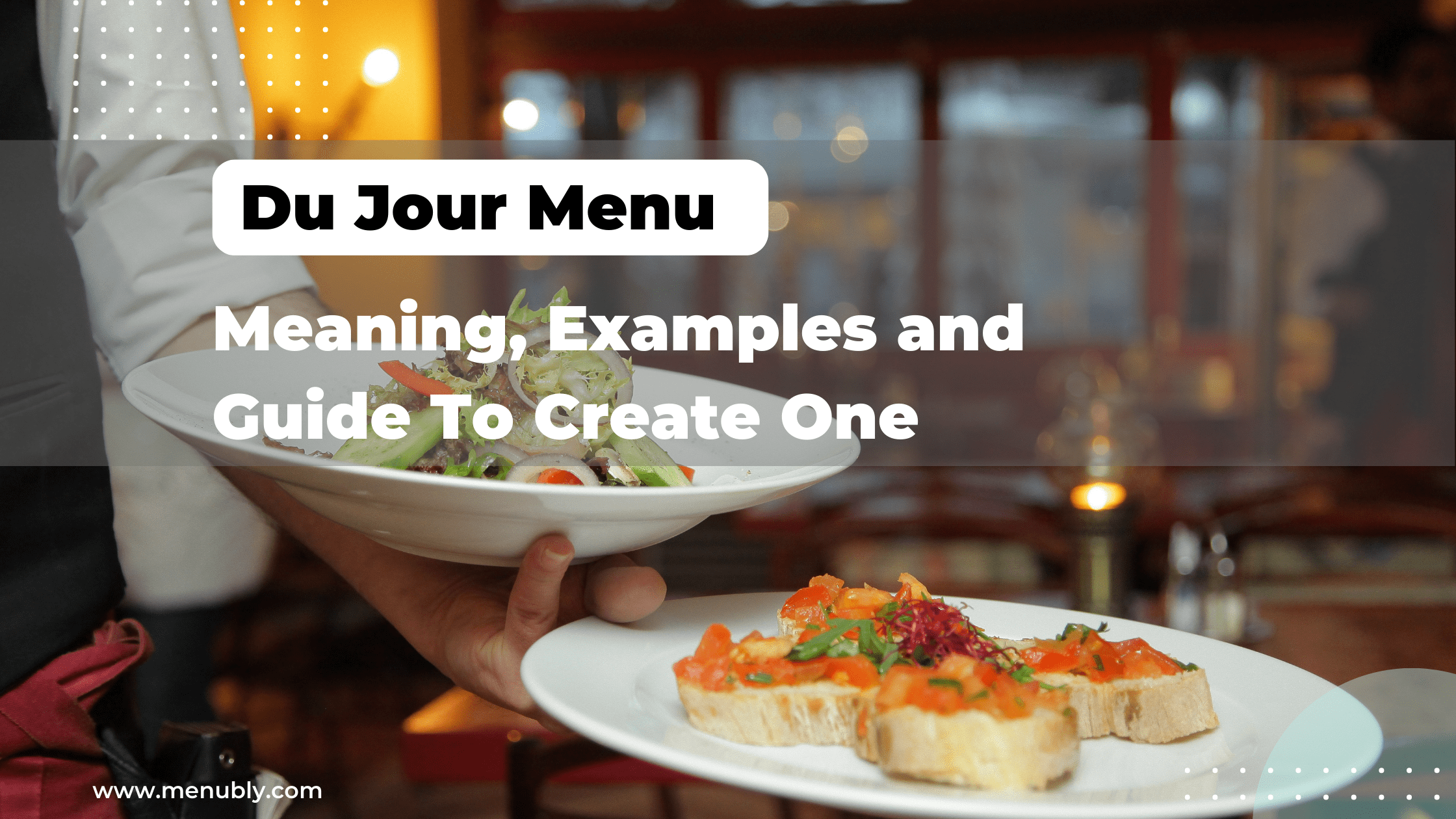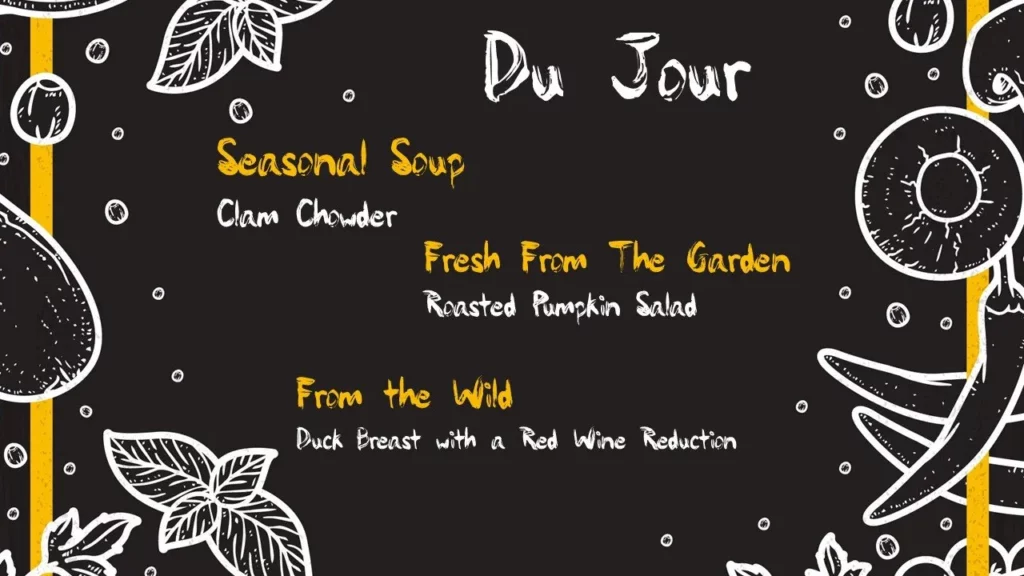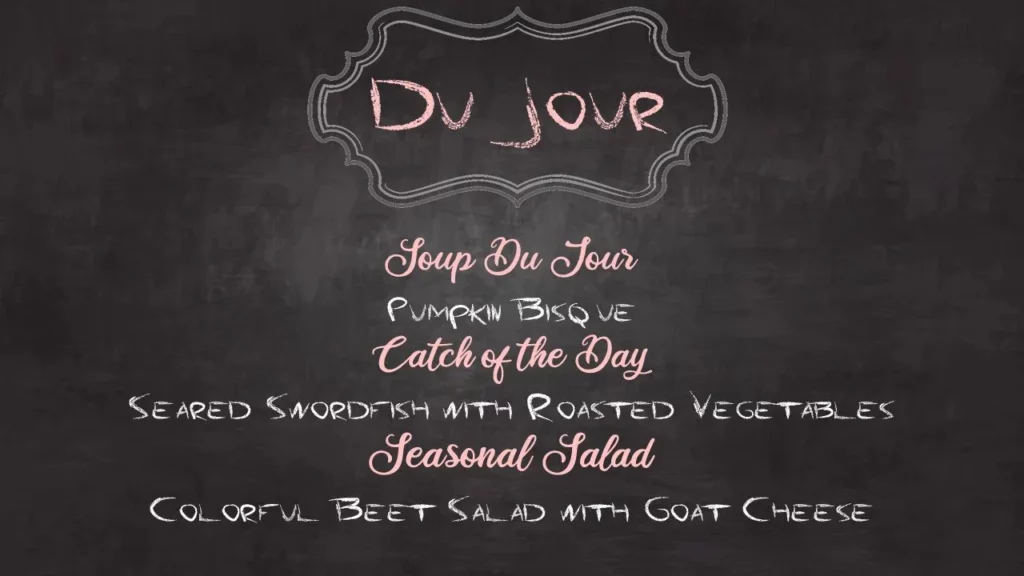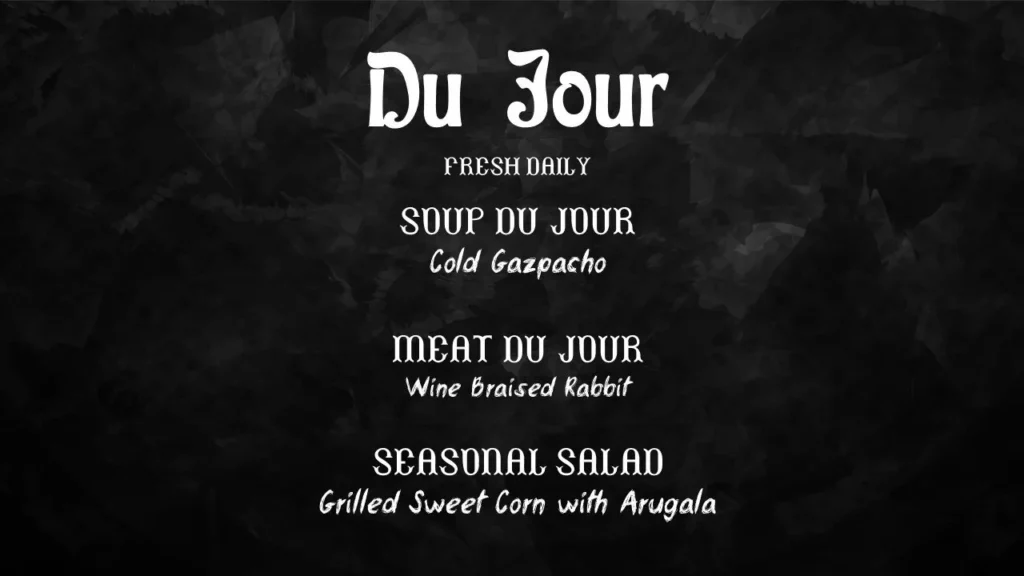
In a world where routine and predictability often reign supreme, the allure of the unexpected is a welcome respite for many. And when it comes to dining, a Du Jour menu promises just that – a culinary adventure where the dishes change daily, offering a unique and delightful experience for both diners and chefs alike. The term “Du Jour,” which means “of the day” in French, captures the very essence of these daily-changing menus, as they showcase the freshest, most seasonal ingredients available, woven into dishes that are truly inspired by the moment.
A Du Jour menu allows diners to embark on a gastronomic journey, savoring flavors and ingredients that might not be available on a standard menu. It keeps the dining experience fresh and enticing, as customers eagerly anticipate the day’s offerings. Meanwhile, chefs have the creative freedom to experiment with different ingredients, techniques, and cuisines, pushing the boundaries of their culinary prowess while minimizing food waste.
In this blog post, we’ll explore the fascinating world of Du Jour menus – their origins, characteristics, benefits, and how to create one. So, get ready to dive into this captivating and delicious world of ever-changing culinary delights!
The term “Du Jour” has its roots in the French language, where it translates to “of the day.” When applied to a menu, it signifies that the dishes presented are specially crafted for that specific day, often utilizing the freshest ingredients and catering to seasonal availability.
To pronounce “Du Jour” correctly, say “doo” (rhyming with “you”) followed by “zhur” (rhyming with “blur”). The term rolls off the tongue with a touch of elegance and sophistication, perfectly capturing the essence of the daily-changing menu it represents.
The concept of a Du Jour menu can be traced back to the early days of European fine dining, where it was customary for chefs to create daily menus based on the freshest ingredients available. This tradition carried over to the United States in the 19th century, as French cuisine became increasingly popular and esteemed.
The French Influence: The French culinary tradition has played a significant role in shaping the concept of the Du Jour menu. French chefs have long been known for their emphasis on seasonality, quality, and the creative use of ingredients. This approach laid the foundation for the emergence of the Du Jour menu in fine dining establishments. Notably, the French Classical Menu has also inspired the structure and style of many modern Du Jour menus.
Early American Adaptation: As French culinary techniques and practices spread across the Atlantic, the Du Jour menu concept gained traction in the United States. Upscale restaurants began to offer daily-changing menus that highlighted fresh, regional ingredients, adding an element of surprise and delight to the dining experience.
Modern Resurgence: In recent years, the Du Jour menu has experienced a resurgence as the farm-to-table movement gained momentum. The emphasis on local, sustainable, and seasonal ingredients has led many chefs to revive this age-old tradition, crafting inventive menus that change daily or weekly, much to the delight of adventurous diners.
With its roots in the rich culinary heritage of France and a modern-day focus on sustainability and seasonality, the Du Jour menu is a testament to the enduring appeal of creativity and spontaneity in the world of fine dining.
A Du Jour menu is a dynamic, ever-changing offering that reflects the freshest ingredients and the chef’s culinary vision. Here are some key characteristics that define a Du Jour menu:
Daily or weekly changes: Du Jour menus are updated frequently, often on a daily or weekly basis, depending on the availability of seasonal ingredients and the chef’s inspiration.
Seasonal ingredients: The focus of a Du Jour menu is to showcase the best of what each season has to offer, highlighting fresh and locally sourced ingredients that provide unique flavors and textures.
Limited availability: Dishes on a Du Jour menu typically have limited availability, as they are created using small quantities of fresh ingredients. This sense of exclusivity adds to the excitement and allure of the dining experience.
Chef’s creativity: Du Jour menus give chefs the opportunity to express their creativity, experiment with new techniques, and explore different cuisines. This results in an eclectic and diverse range of dishes that keep diners intrigued and eager to return.
Adaptability: The ever-changing nature of Du Jour menus allows restaurants to adapt to fluctuations in ingredient supply, ensuring minimal food waste and the ability to cater to the tastes of their clientele.
1. Unique Dining Experiences
A Du Jour menu offers a tantalizing escape from the ordinary, as each visit to the restaurant unveils new, unexpected culinary delights. The ever-changing menu keeps diners on their toes, sparking excitement and anticipation with every visit.
2. Seasonal and Fresh Ingredients
Similar to seasonal menus, du jour menus focus on ingredients at the peak of their freshness and flavor, hence deliver an unparalleled dining experience. Dishes are crafted with produce that embodies the essence of each season, offering a vibrant and delicious taste of the world around us.
3. Dietary Variety
The dynamic nature of Du Jour menus ensures a diverse array of dishes, catering to various dietary preferences and restrictions. From hearty meat dishes to light, plant-based fare, the ever-changing menu offers something for everyone, keeping diners engaged and satisfied.
1. Minimizing Food Waste
By tailoring their menus to the availability of fresh ingredients, restaurants can efficiently utilize their resources and minimize food waste. The flexible approach to menu creation allows chefs to make the most of their ingredients, reducing costs and contributing to a more sustainable operation.
2. Flexibility in Sourcing Ingredients
A Du Jour menu affords restaurants the freedom to source ingredients based on availability, quality, and pricing. This adaptability allows them to take advantage of seasonal surpluses, local farmers’ markets, and unique suppliers, ensuring the finest ingredients make it to the plate.
3. Encouraging Culinary Creativity
The ever-evolving Du Jour menu is a playground for culinary creativity, allowing chefs to explore new techniques, flavor combinations, and cuisines. This constant innovation not only keeps the dining experience fresh and exciting but also fuels the passion and growth of the restaurant’s culinary team.
Du Jour menus come in various forms, each designed to offer unique culinary experiences while highlighting the freshest ingredients available. Here are some common types of Du Jour menus:
Daily specials are a popular way for restaurants to incorporate a touch of the Du Jour concept into their regular offerings. These limited-time dishes can be based on seasonal ingredients or the chef’s latest inspiration, providing a daily dose of excitement for both the kitchen staff and diners. Expect lunch or dinner entrees, as well as great dessert options, to be fresh and without any compromises on quality.
Seasonal menus, as the name suggests, change according to the time of year, showcasing the best ingredients each season has to offer. These menus not only highlight fresh, flavorful produce but also create a dining experience that aligns with the mood and atmosphere of the season. Guests can look forward to a select range of lunch and dinner options that perfectly capture the essence of the season.
Chef’s specials are dishes that showcase the chef’s creativity and expertise, often featuring unique ingredients or techniques. These specials are a prime opportunity for chefs to experiment with new ideas and present their culinary vision to guests. From enticing entrees to delectable desserts, the chef’s specials promise a dining experience unlike any other.
Limited-time offers are another way restaurants can introduce a Du Jour menu element. These promotions can be based on holidays, local events, or collaborations with other chefs or suppliers, providing a unique and engaging dining experience for a short period. Whether it’s a themed dinner or a special lunch menu, guests can expect an array of exceptional dishes crafted with care and creativity.
Creating a Du Jour menu is an exciting opportunity for chefs to showcase their creativity and adaptability. Here are some key factors to consider when designing a Du Jour menu:
The first step in crafting a Du Jour menu is to find inspiration. Look to several sources to spark your creativity:
Seasonal produce: Visit local farmers’ markets or connect with local suppliers to see what fresh ingredients are available. The season’s bounty can serve as the foundation for your menu items.
Culinary trends: Stay up-to-date with the latest culinary trends and techniques, incorporating them into your dishes to create a contemporary dining experience.
Cultural influences: Explore different cuisines and cultures for unique flavor combinations and cooking methods that can elevate your menu.
Personal experiences: Draw on your own memories and experiences, using them as a starting point for crafting dishes that tell a story.
To keep diners engaged, it’s essential to strike a balance in your Du Jour menu. Consider these factors:
Diversity: Offer a mix of dishes, including starters, entrees, and desserts, that cater to various tastes and dietary preferences. This may mean featuring vegetarian or vegan options alongside meat-based dishes, or offering lighter dishes alongside more indulgent fare.
Portion sizes: Balance portion sizes to provide satisfying meals without overwhelming diners. Instead of one large side, for example, consider offering a few smaller sides that complement the main course.
Flavor profiles: Ensure your menu items feature a range of flavors, from sweet to savory and mild to spicy, to create a dynamic and satisfying dining experience.
When designing a Du Jour menu, keep these tips in mind to increase its appeal:
Visual presentation: Make your menu visually appealing by using a clean, organized layout and high-quality images of select dishes. This will give diners a glimpse of what they can expect.
Menu descriptions: Craft enticing descriptions for each dish, highlighting key ingredients and flavors. This helps diners understand and appreciate the thought and effort that went into each menu item.
Pricing strategy: Price your dishes fairly, considering factors like ingredient costs, labor, and your target audience. Transparent pricing can go a long way in building trust and loyalty among your customers.



Du Jour Menu vs Other Types of Menu
Understanding the differences between Du Jour and other types of menu can help you select the best approach for your restaurant. Here’s a comparison of the Du Jour menu with other common menu types:
A Du Jour menu features daily-changing dishes based on seasonal ingredients and chef’s inspirations, while a Table d’hote menu offers a fixed number of courses at a set price. With a Table d’hôte menu, you can expect a limited choice of dishes for each course, such as an appetizer, entrée, and dessert. Du Jour menus often allow more room for creativity and flexibility, as they can be updated daily to feature the freshest ingredients.
An A La Carte menu allows diners to choose individual dishes from a more extensive selection, with each item priced separately. Du Jour menus, on the other hand, focus on a smaller, daily-changing selection of dishes based on the availability of fresh ingredients. While A La Carte menus offer more choice, Du Jour menus provide a unique, curated dining experience with an emphasis on seasonal flavors.
The du jour menu and tasting menu are both set menus offered by restaurants. The main difference is that the du jour menu changes daily, while the tasting menu is a predetermined sequence of courses. The goal of the du jour menu is to feature fresh ingredients and offer variety, while the goal of the tasting menu is to provide a curated culinary experience.
Cyclic menus are pre-planned menus that rotate through a set number of dishes over a specific period, such as weekly or monthly. Du Jour menus differ in that they change daily based on the chef’s inspiration and fresh ingredients. While cyclic menus offer predictability and can be served quickly, Du Jour menus provide a more dynamic, personalized dining experience that showcases the chef’s creativity and expertise.
An Ethnic menu features dishes from a specific culture or region, often highlighting traditional flavors and cooking techniques. Du Jour menus, however, focus on fresh, seasonal ingredients and may draw inspiration from various cultures and cuisines. Although Ethnic menus can offer a deeper exploration of a particular culinary tradition, Du Jour menus allow chefs to prepare a diverse array of dishes that cater to a broader audience, while still using the freshest ingredients possible
Technology has become an integral part of the modern dining experience, and Du Jour menus are no exception. Here are some ways technology can enhance and streamline the process of creating and promoting Du Jour menus:
Digital menus are a game-changer for restaurants offering Du Jour menus. Since these menus change daily, traditional printed menus can be time-consuming and costly to update. Digital menus, on the other hand, make it easy to modify and display the latest offerings without complex logistics. Furthermore, digital menus can incorporate eye-catching visuals and interactive features, giving diners a more engaging experience. Due of sanitary concerns, the entire industry is moving away from paper menus. A digital menu solves that problem by having a QR code menu. A customer scans a dynamic QR code to bring up the menu on their smart device. It’s so simple, safe, and convenient
Online ordering platforms simplify the process of offering Du Jour menus for takeout or delivery. These platforms allow restaurants to update their menu offerings in real-time, ensuring customers have access to the latest options. This convenience allows diners to enjoy the fresh, seasonal dishes of a Du Jour menu in the comfort of their own homes.
Social media plays a significant role in promoting Du Jour menus. Restaurants can create buzz around their daily-changing offerings by sharing mouth-watering photos, behind-the-scenes glimpses, and stories about the inspiration behind each dish. By actively engaging with their audience on social media, restaurants can build anticipation and excitement for their Du Jour menus, attracting new customers and encouraging repeat visits.
“Soup du jour” is a French term that translates to “soup of the day.” It refers to a restaurant’s daily special soups, typically prepared using fresh, seasonal ingredients. Offering soup du jour allows chefs to showcase their creativity and ensures diners can expect a fresh, unique soup experience each day.
Du Jour menus are created by chefs based on the availability of fresh, seasonal ingredients and their culinary inspiration. Chefs may draw from a variety of sources, such as local farmers’ markets, culinary trends, or cultural influences, to craft daily-changing dishes that highlight the best of what’s in season.
Restaurants across various cuisines and types of service can use Du Jour menus. From fine dining establishments to casual eateries, Du Jour menus offer chefs the opportunity to showcase their creativity and provide guests with a unique, ever-changing dining experience centered around fresh, seasonal ingredients.
While Du Jour menus can be more complex to plan and execute than static menus, they offer several cost-saving benefits. By utilizing fresh, seasonal ingredients, restaurants can often source items at lower prices. Additionally, Du Jour menus allow for better inventory management, helping to minimize food waste and associated costs.
Yes, Du Jour menus can contribute to increased customer satisfaction by offering diners a unique, personalized experience each time they visit. With daily-changing menus, guests can enjoy a wider variety of dishes and flavors, which can encourage repeat visits and foster greater loyalty to the restaurant.
When setting up your restaurant, it’s crucial to explore ways to attract more customers to your restaurants. One effective way to do this is by having a dedicated website where your customers can learn everything about your restaurant anytime, anywhere.
Menubly Website Builder lets you create a mini website with a built-in digital menu which centralizes all important information about your restaurant into one accessible link. It makes it easy for your customers to interact with your restaurant: they can view your menu, find your location, book a table, place delivery orders… all in one place.
By adding your mini website link in your Instagram bio and other social media profiles, or sharing it directly with customers, you make it easy for them to discover and engage with your restaurant through a single, convenient link. This streamlined approach not only enhances customer experience but also boosts your online presence and attract more customers.
Best of all? You can set up your Menubly website for Free in just under 5 minutes and tailor it to match your restaurant’s style.
Ready to boost your restaurant’s online presence? Click here to create your free website with Menubly!
Du Jour menus are an enticing option for restaurants that wish to offer a unique, daily-changing dining experience centered around fresh, seasonal ingredients. These menus allow chefs to showcase their creativity and provide diners with memorable culinary experiences. Du Jour menus also offer numerous benefits for restaurants, such as minimizing food waste and encouraging flexibility in sourcing ingredients.
As the focus on sustainability and local sourcing in the food industry continues to grow, Du Jour menus are likely to gain even more popularity. By embracing technology and leveraging social media, restaurants can enhance the appeal of their Du Jour menus and connect with a wider audience. Moving forward, we can expect to see more restaurants adopting Du Jour menus as they strive to offer diners an unforgettable experience that highlights the freshest ingredients and innovative culinary creations.
Follow Us